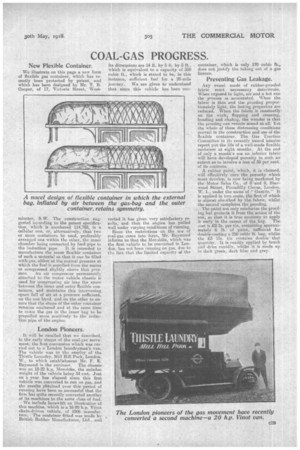COAL-GAS PROGRESS.
Page 17

If you've noticed an error in this article please click here to report it so we can fix it.
New Flexible Container.
We illustrate on this page a new form of flexible gas container, which has recently been protected by patent, and which has been designed by Mr. T. B. Cooper, of 17, Victoria Street, West
minster, S.W. The construction suggested according to the patent specification, which is numbered 114,788, is a cellular one, or, alternatively, that two or more containersbe used, preferably arranged one -within the other, the inner chamber being connected by feed pipe to the induction. pipe. It is intended to manufacture the inner flexiblecontainer of such a material so that it can be filled with,gas, either at the normal pressure at which the fuel is supplied from the mains or compressed slightly above that pres sure. An air compressor permanently attached to the motor vehicle. chassisis used for compressiina air into the space between the inner and outer flexible containers, and maintains this intervening space full of air at a. pressure sufficient, on the one hand, and on the other to ensure that the shape of the outer container remains unaltered and at the same time to cense the gas in the inner hag to be propelled more positively to the induction pipe of the engine.
London Pioneers.•
It will be recalled that we described, in the early stages_ of the coal-gas movement, the first conversion which was carried out to a London laundryman's van. The vehicle. was in the employ of the Thistle Laundry, Mill Hill Park, London,
• W., to which establishment Mr. F. E. Raymond is the engineer. The Chassis
• was an 18-22 h.p. Mercedes, the unladen weight of the vehicle being 34 cwt. Just on a year has elapsed_ since this first vehicle was converted to run on gasr and the results obtained over this period of running have been so successfulthat the firm has quite recently converted another of its machines to the same class-of fuel.
We include herewith an ilhietration of this machine, which is a 16.20 h.p. Vinot chain-driven vehicle, of 1906 manufacture. The container fitted was made by British Rubber Manufactures, Ltd., and its dimensions are 14 ft. by 5 ft. by 5 ft., which is equivalent to a capacity of 350 cubic IL, Which is stated to be, in this instance, sufficient fuel for a 20-mile Journey. We are given to understand' that since this vehicle has been con verted it has given very eatisfactery restilts, and that the engine has pulled Well Under varying conditions of running.
Since the restrictions on the mze. of coal-gas came into force, Mr. Raymond informs us that the Mercedes which was the first vehicle to be converted in London, has not been running on gas, doe to the fact that the limited capacity al the container, which is -only 170 cubic ft., does not justify the taking out of a gas licence.
Preventing Gas Leakage.
Any vessel made of rubber-proofed fabric mast necessarily deteriorate. When exposed to light, air and a hot sun the peoce.ss IS accelerated, When the fabric is thin and the proofing ,propoetionately light, the lasting properties are reduced. . When the fabric is constantly% on the work, flapping and creasing, bending and chafing, the wonder is thatthe proofing can remain sound at all. Yet the whole of these distressing conditions prevail in the construction and use of the flexible container, The Gas Traction Committee in its recently issued interim _ report put the life of a well-made flexible container at eight months. At the end of only a month's use an inferior fabric will have developed porosity to such an extent as to involve a loss of 50 per cent. of its contents.
A rubber paint, which, it is claimed, will effectively cure the porosity which must develop, is now being marketed by the Motor Sales Co. of 8 and 9, Sherwood Street, Piccadilly Circus, Loudon, W. 1., under the-name of " Gaztite." It is applied in two coats,. the fiestiof which is almost absorbed lay thq fabric, whilst the second completes the proofing. . The paint not only reinforces the proofing but protects it from the action of the sun, so that, it is true economy to apply it early in the career of the hag. The cost is"2 2s. per tin, containing.approximately 6 lb.of paint, 'Sufficient for double-coating a 250 cubic ft. bag, whilst the £3 15s. tin ceatains double that quantity.. It is readily applied by brush and dries rapidly, whilst it. is made up in dark green, dark blue and grey.






















